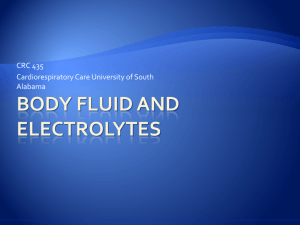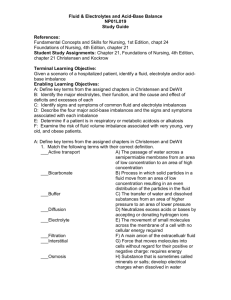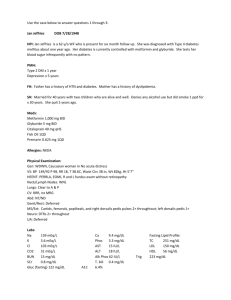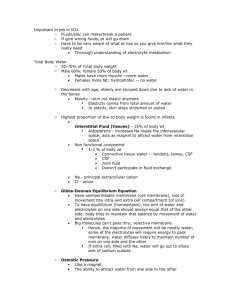Fluid and electrolytes, acid base balance, AND IV fluids
advertisement
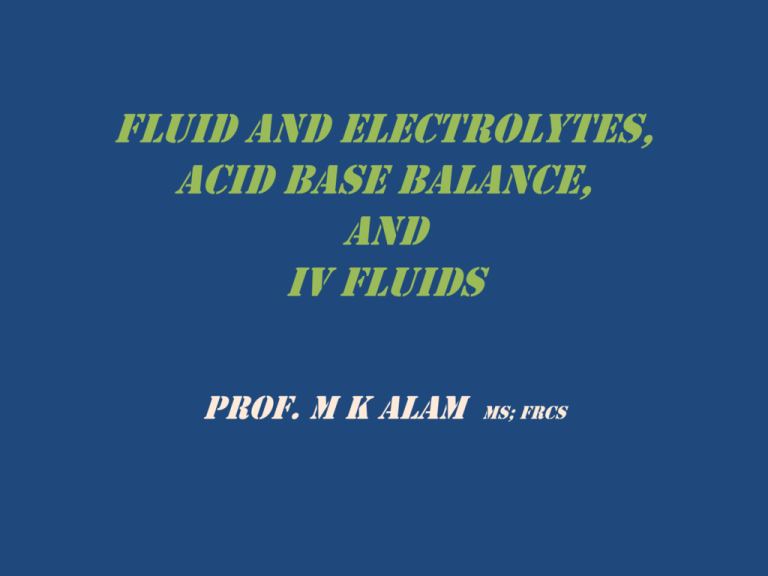
Fluid and electrolytes, acid base balance, AND IV fluids Prof. M K Alam MS; FRCS Intended Learning Outcomes- ILOs At the end of this presentation students will be able to: Understand the normal & abnormal fluid and electrolyte status in the body. Describe how the body maintains the homeostasis. Identify and manage fluid and electrolyte abnormalities. Understand the mechanism of acid base balance. Identify and mange acid base disorders Describe different IV fluids and its uses. Fluid and electrolytes Fluid & electrolytes management form an integral part of surgical care Fluid and electrolytes • Homeostasis- integrated action of cellular membrane, specific organs , local and systemic hormones • Diseases, trauma, surgery & medicationscan adversely affect the equilibrium Fluid and electrolytes Total body water (TBW) • 60% of body weight (range 50-70%) • Contained primarily in skeletal muscle • Slightly higher in men • Declines steadily with age • Obese has less body water (Fat is devoid of water) Fluid Compartments • Intracellular - 40% of body weight • Extracellular- 20% of body weight - Interstitium 15%, - Intravascular or plasma 5% • Compartments separated by semipermeable membrane to maintain the composition differences INTRACELLULAR electrolytes • Dominant cation- K⁺ (160 mEq/L) , Mg⁺ • Anions- phosphates (HPO₄) and proteins Extracellular electrolytes • Dominant cation- Na⁺(140 mEq/L) • Anions- chloride (Cl⁻), bicarbonate (HCO₃⁻) Fluid and electrolytes Electrical neutrality- balance of cations and anions on either side of the membrane Fluid and electrolytes • Osmotic forces are prime determinant of water distribution in the body • Major determinants of osmotic activity in plasma are Na⁺, glucose & urea • Normal serum osmolarity 285 mOsm/L Fluid and electrolytes • Regulation of fluid volume mainly by kidney • Osmoreceptors in posterior Pituitary: ADH release promote retention of free water by distal renal tubules & collecting ducts. • Renin-angiotensin-aldosterone system: Acting on kidney increases water &Na⁺ reabsorption, K⁺ & H⁺ excretion by distal renal tubules. • Baroreceptors in kidney & carotid: Small role Fluid balance Normal state: Fluid gain = fluid loss FLUID GAIN: Oral intake- 2-3 L/ day (2/3rd fluid+ 1/3rd solid) Oxidative metabolism of protein & fat- 400-500 ml/ day Fluid balance • FLUID LOSS: Urine 1-1.5 L /day, Faeces 250 ml/day Insensible loss from skin & lung- 600-900 ml/day (loss increases by 10% for each 1°C rise in body temperature) MAINTENANCE OF FLUID REQUIREMENTS 100 ml / 1st 10 kg, 50ml / 2nd 10kg, 20 ml / subsequent kg body weight 70-kg man 2500 ml / day = 35 ml / kg Water & Electrolyte abnormalities Fluid volume deficits (isotonic) • Aetiology: Vomiting, nasogastric output, GI fistulas, lengthy abdominal surgery (10ml/kg/hr.), sepsis, inflammation (3rd space loss ) • Acute loss: Hypotension, tachycardia, oliguria, altered mention • Chronic loss: Oliguria, loss of skin turgor, orthostatic hypotension, low urine Na⁺ and BUN/creatinine ratio >15:1. Fluid volume deficits (isotonic) • Hematocrit- elevated 5%-6%/ L volume deficit • Treatment: Isotonic solutions (RL, NS) to restore physiologic parameters (urine >0.5ml/hr., hemodynamic status) Volume deficits (uncommon types) • Hypotonic dehydration: Iatrogenic, Inadequate resuscitation with hypotonic solutions • Hypertonic dehydration: Impaired consciousness or thirst mechanism, Inability to obtain water Fluid volume excess • Excessive parenteral fluid administration (5% Dextrose). • Failure of adjustments to intake/output. • Elderly, cardiac and renal disease patients at risk • Peripheral edema, pulmonary edema, weight gain, elevated CVP (normal 5-12mm Hg) • Treatment: Fluid restriction, loop diuretics Sodium homeostasis • Normal serum level:132-144 mEq/ L • Daily dietary intake: 100-250 mEq (6-15 g/day) • Excreted through urine, stool and sweat • Daily urinary excretion: 50-90 mEq/ day • Renal regulation: reduced loss to 1 mEq/day or exceed 5000 mEq/day Hyponatremia • Hypervolemic: Renal failure-↓water loss, CCF, Cirrhosis, COPD- ↓CO → ↑water absorption. • Normovolemic: Urinary Na⁺ loss in Syndrome of inappropriate secretion of ADH (SIADH) -head injury, stroke, carcinoma lung • Hypovolemic: Hypotonic solutions infusion, Loss of Na⁺ in renal disease- urinary Na⁺ ↑20mEq/L Hyponatremia • Symptoms: Na⁺ ˂120 mEq/L Lethargy, confusion, seizures, anorexia, vomiting, coma • TSD (total Na⁺ deficit)= 0.6 x wt. in kg x(140- actual Na⁺ level) Deficit correction 0.5 mEq/L/ hr. Rapid correction leads to myelin sheath damage • Treatment: Severe symptoms- rapid correction to 120 mEq/ L, then slowly. Hypervolemic- fluid restriction, loop diuretics SIADH- fluid restriction + loop diuretic + vasopressin 2 antagonist Hypovolemic- normal saline Hypernatremia • Aetiology: - Excess salt intake or reduced salt loss - Reduced water intake or excess water loss • Types: - Hypernatremia with volume depletion most common, - Hypernatremia with volume excess or normal volume • Pathophysiology: - Net Na⁺ gain (hyperosmolar state) leads to water shift from intracellular to extracellular space (intracellular dehydration) - Hyperosmolar state leads to thirst & ADH release Hypernatremia • ADH abnormalities - cause massive water loss • Abnormalities of synthesis - central diabetes insipidus • Abnormalities of action- nephrogenic diabetes insipidus • Central diabetes insipidus- head injury • Nephrogenic diabetes insipidus- side effect of lithium, interstitial nephritis, obstructive uropathy Hypernatremia • Symptoms: usually starts at > 160 mEq/L . Symptomatic at a lower level if rise in Na⁺ level is rapid • Mainly CNS related- restless, irritable, fever, seizures. • Treatment: Isotonic saline to correct hypovolemia followed by D5 W infusion to correct water deficit • Water deficit= normal BW x normal Na⁺ level/ current Na⁺ level Potassium homeostasis • Principal intracellular (155 mEq/L) cation • Mostly located in skeletal muscle • Normal serum level 3.5- 5 mEq/L • Concentration gradient maintained by- membrane bound Na⁺-K⁺ ATPase pump. Potassium homeostasis • Daily K⁺ intake: 1-1.5 mEq/kg body weight • 90% excreted through kidney • Internal regulating factors: Insulin, aldosterone, catecholamines and acid-base balance Hyperkalemia • Serum K⁺ > 5.5 mEq/ L • Aetiology: Renal failure, adrenal insufficiency, metabolic acidosis, hemolysis, rhabdomyolysis, seizures, sever GI bleeding, medications (NSAID), excessive K⁺ administration Hyperkalemia • Pseudohyperkalemia: Thrombocytosis, leukocytosis, excessive agitation of specimen, prolonged tourniquet or excessive fist clenching during blood drawing • Myocardial toxicity ( K⁺> 6 mEq)- peaked T wave, prolonged PR interval, complete heart block, paresthesia, flaccid paralysis Hyperkalemia • Treatment: • 10% Ca-gluconate 10-20 ml- cardioprotective, effective in 1-5 min. • 10 units insulin in 50 ml + 50% Dextrose- effective in 15-45 min. • 100 mEq of sodium bicarbonate - if metabolic acidosis • K⁺exchange resin 50-100 gm enema- slow action • Hemodialysis Hypokalemia • K⁺ ˂ 3.5 mEq/L • Aetiology: Vomiting, diarrhea, GI fistula, diuretics • Metabolic alkalosis often coexists (↓ renal conservation) • Weakness, flattening of T wave, arrhythmias in patients on digoxin • Treatment: IV K⁺ for severe cases Oral K⁺ 60-80 mEq/ day for milder cases Calcium Homeostasis • 99% body Ca⁺- in bone, not readily exchangeable • Homeostasis- exchange between bone and ECF, renal excretion, and intestinal absorption • Homeostasis mainly controlled by PTH • Plasma calcium: 10 mg/dl. • ECF Ca⁺: Ionized, Non-ionized, Protein-bound Calcium Homeostasis • Low ionized Ca⁺ → ↑ PTH and ↑ 1,25-dihydroxyvitamin D3 Both stimulate bone absorption by increasing osteoclastic activity • Increased ionized ca → ↓ PTH and ↓1,25-dihydroxyvitamin D3, which decreases bone absorption • Intestinal absorption- primarily on 1,25-dihydroxy vitamin D3, • Renal excretion: PTH and vitamin D increases distal tubular reabsorption of calcium. Calcitonin inhibits calcium reabsorption • Alkalosis ↑ ca excretion, acidosis ↓excretion Hypercalcemia • Aetiology: Hyperparathyroidism, malignancy, thiazide, acute adrenal insufficiency, prolonged immobilization • Clinical features: CNS: Muscle fatigue, weakness, personality disorders, psychoses, confusion, depression, and coma CVS: Hypertension, shortening of QT interval GIT: Nausea, vomiting, and abdominal pain Renal: Nephrocalcinosis → chronic renal failure, Nephrolithiasis Treatment of Hypercalcemia • Promote diuresis by infusion of normal saline • Add KCl 20-30 mEq / L of intravenous fluid • Furosemide to enhance calcium excretion • Treat the underlying cause: -Primary HPT: Surgery -Bone metastasis: Bisphosphonates, calcitonin, steroids Hypocalcaemia • Aetiology -Thyroid or parathyroid surgery -Acute pancreatitis -Pancreatic and small bowel fistulae -Vitamin D deficiency: Malabsorption, lack of exposure to sunlight -Renal failure →Vit. D₃ deficiency→ ↓ intestinal absorption • Clinical features: (ca < 8 mg/dL) Muscle cramps, perioral tingling, paresthesia, laryngeal stridor, tetany, seizures, and psychotic behavior, hyperactive deep tendon reflexes. Treatment of Hypocalcaemia • IV calcium (calcium gluconate or calcium chloride) 50 mg/minute (2.5 mEq/minute) • Oral calcium ( citrate, carbonate) • Vitamin D₃ (Calcitriol)- increases intestinal absorption Magnesium • Total body content : 2,000 mEq- 50% in bone, the remaining in the intracellular space. • < 1% of total in the extracellular space (1.4 to 2 mEq/L or 1.7 to 2.3 mg/dL). • Daily intake: 25 mEq • Excretion primarily by the kidneys • Excretion increased by hypermagnesemia, hypercalcemia, metabolic acidosis, and phosphate depletion. Excretion decreased by metabolic alkalosis. Hypermagnesemia • Aetiology: chronic or acute renal failure, Mg-containing antacids/ laxatives intake , severe burns, crush injuries, rhabdomyolysis, severe metabolic acidosis, extracellular volume depletion • Clinical features: Depressed neuromuscular function. Loss of deep tendon reflexes, paralysis , coma. Hypotension or even cardiac arrest can occur if levels exceed 18 mg/dL. Treatment of Hypermagnesemia • Calcium- 5 to 10 mEq, slow i.v (antagonizes the effects of magnesium) • Volume expansion • Correction of acid-base disturbances • Loop diuretics • Hemodialysis • Avoid Mg- containing medications Hypomagnesemia • Aetiology: Malnutrition, steatorrhea, increased GI losses , prolonged IV fluid replacement without Mg, loop diuretics, aminoglycosides, insulin for DKA, diuretic phase of acute renal failure • Clinical features: Similar to hypocalcemia Muscle fasciculations, weakness, tetany, carpopedal spasm, nausea, vomiting, and personality changes. Hypokalemia by renal K wasting. Treatment of hypomagnesemia • Mild cases: oral magnesium • Large deficit: IV Mg-sulfate 50-100 mEq/ day ACID-BASE BALANCE ACID-BASE System • Acid: donate a H⁺ ion – HCl , H2CO3 • Base: accept a H⁺ -HCO3 • Acid-base homeostasis: equilibrium in H+, PCO2, and HCO3• H+ concentration - expressed as pH • Normal pH - 7.35 to 7.45 • Acidemia - pH < 7.35 • Alkalemia- pH > 7.45 Acid-base disturbance • Acidosis- respiratory, metabolic. • Alkalosis- respiratory , metabolic • Assessment- arterial blood gas analysis (radial artery) • Normal ABG report: pH- 7.36- 7.44 H⁺- 44-36 nml/L HCO₃- 23-28 mmol/L pCO₂- 36-44 mmHg (4.8-5.9 kPa) pO₂- 80- 100 mmHg (10.6- 13.3 kPa) Acid-base disturbance Compensatory mechanisms: 1. Respiratory compensation- most rapid (minutes) 2. Blood buffers (in hours) Blood buffers - bicarbonate (65%)- most important, protein 30% Respiratory system. Kidneys. 3. Kidney (days) Metabolic acidosis • ↓ pH, ↓ bicarbonate concentration. • Increased production of endogenous acids ( increased anion gap acidosis) shock, severe hemorrhage, liver failure, diabetic ketoacidosis. • Increased bicarbonate loss (normal anion gap acidosis)- diarrhoea, intestinal fistula. • Respiratory compensation- fall in pCO₂ - resp. alkalosis • Treatment: Fluid resuscitation, base deficit correction by bicarbonate Metabolic alkalosis • ↑ pH, ↑ bicarbonate concentration. • Respiratory compensation - ↑pCO₂ - resp. acidosis • Associated with hypokalemia, hypochloraemia. • Aetiology: Loss of acid as vomitus in gastric outlet obstruction. • Treatment: Replace fluid, K⁺ and chloride and treatment of primary cause Respiratory acidosis • ↑pCO₂, ↑plasma bicarbonate, ↓pH • Respiratory depression (head injury, opioids drugs) • Pulmonary disease (asthma, COPD) • Metabolic compensation- renal bicarbonate retention. • Treatment: Ventilatory support. Respiratory alkalosis • Result of hyperventilation- pain, hysterical hyperventilation, CNS disorders, salicylate poisoning, liver failure. • ↑pH, ↓pCO₂ • May develop tetany- ↓ ionized Ca⁺ due to alkalosis. • No specific treatment Types of intravenous fluid • 5% Dextrose: 5Gm dextrose/ 100 ml, isotonic, not useful in resuscitation. • 10, 20 & 50 % Dextrose:- Hypertonic , used for diabetics or hypoglycemics. • Normal saline: 0.9% NaCl, 9Gm NaCl in 1L (Na 154 mmol), pH 5. • Ringer’s lactate (Hartman’s): < NaCl ( Na 131 mmol) + K⁺, HCO₃, Ca⁺ & Mg⁺, pH 6.5 • NS & RL: For replacing ECF loss. RL closely match ECF and less risk of hyperchloremia. • Hypertonic saline: Used for hyponatraemic seizures, cerebral oedema. • Dextrose Saline: 5% Dextrose with N saline- hypertonic, used with caution. 4.3% Dextrose with 1/5 N saline more safe. • Colloids: Albumin (4.5%), gelatin, hydroxyethyl starch [HES], dextran- all stay longer in intravascular space after resuscitation. Side effects- coagulopathy, pruritus, anaphylactic reaction Maintenance fluid & electrolyte in 24 hours Example for an adult in normal condition: • Normal saline: 500- 1000 ml + • 5% Dextrose: 2 L- 2.5 L + • Potassium chloride: 60-80 mmol added to IV fluids. • Adjust according to intake/output, and serum electrolytes result.
